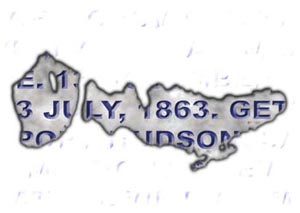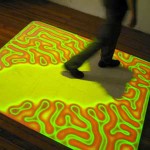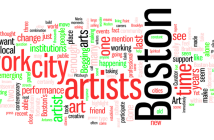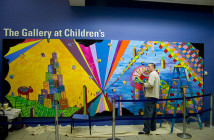Deep Wounds is nothing new from Brian Knep, though it was a commissioned piece, and—to his credit—by both the Office for the Arts of Harvard University and the Department of Systems Biology of Harvard Medical School. If you are familiar with Knep’s work, the commissioning by the Department of Systems Biology might not surprise you, as the software algorithms he uses model forms and movement as organic or ‘living.’ The unlikely alliance between art and science, as far as the final work is concerned, ends with that connection, but the visceral response the work elicits from the viewer structures the living quality of the work. Knep uses essentially the same computer software and hardware for Deep Wounds that he built his Healing Series (2004) on, but placed a metaphor about Harvard’s history around it.
The work is comprised of video projected on the white marble floor of the “transept” of Harvard’s Memorial Hall. Initially the projections seem to only be large rectangles of white light with little texture, as if a “skin,” but when a viewer—or participant—disturbs the broad ray of light emanating from the ceiling by waving an arm or simply walking across the projection field, the shadow cast on the floor remains for a split second and the projected skin breaks apart to reveal blue text. The text is in the same style and font as the names of the Harvard graduates from the Union Army who died in the Civil War that are inscribed in red on the walls of the same hall. Included with the Union soldiers’ names are their year of graduation and the date and battle of their death. Just as the skin opens up, or “blisters,” it immediately begins to “heal” in much the same way his Healing Series worked, covering up the red text. The field of light quickly begins to resemble some sort of photosensitive goo as more and more participants engage the piece; the goo seems to perish without the light, yet, immediately grows back or reproduces when the light is restored. The blue text projected on the floor is made up of Confederate soldiers’ year of graduation and the date and battle of their death (in the same way as the Union soldiers’, but in their names’ stead, the role they carried in a relationship with another person, e.g. classmate, brother, etc). The names are placed on the floor to chronologically parallel their Union counterparts on the wall.
But is the literally hallowed hall outside the Sanders Theatre the right place for a New Media work? I’ll leave the answer to that question for the Harvard undergrads munching on college cuisine in the dining hall located in the very same building; though, call me a prig, but a temporary video installation may not be the best way to provide a counter-memorial for former Harvardians killed in the Civil War under the Confederate Flag. The technology of the work might even become more apparent than Knep’s previous works, which use the same methods, due to the clash of the Knep aesthetic with that of Harvard’s. The work that spawned this piece, and perhaps more to come, addressed the abstract questions of wounding and healing, technology and 'soul'. But this work uses the media, or ‘apparatus’, created by Knep to address something much more cerebral.
The institutional confines the work, a metaphor about Harvard’s relationship with its Union and Confederate dead, hampers the work’s creative process. Originally, Knep had wanted to list the name’s of Harvard’s Confederate Civil War dead, but according to an April 7, 2006 Boston Globe article, Harvard’s Office for the Arts thought it would be too controversial. In the end, Knep reached a compromise that “felt right,” and was rather fortuitous considering the impetus behind the change was institutional reactionism. Foregrounding the confederate soldiers’ relationships with other people (and classmates at Harvard), causes the viewer to grapple with the historical context of the work.
Knep’s interactive apparatus, as in his Healing Series or here in Deep Wounds, creates a way for the viewer to engage the works’ concepts that compels his or her physical and intellectual reaction. Knep’s application of this apparatus in Deep Wounds is not only a metaphor for the historical scars of Harvard and the United States, but also a tool for learning and understanding. The projections all have an equilibrium that only the viewer can change, and it is through the viewer’s inquisitiveness, which the work incites, that they impart the information, or knowledge, within Knep’s piece. In the state of equilibrium, the wounds of the past stay hidden, seemingly the place Harvard would like them to be, yet with the viewer’s interaction and curiosity the wounds are re-opened, and the past is given a chance to finally be reconciled.
----
Links:
Brian Knep
Memorial Hall at Harvard University
SEVEN QUESTIONS WITH BRIAN KNEP by MATTHEW NASH in issue #15
"Deep Wounds" is on view April 6 – April 23, 2006 at Harvard's Memorial Hall.
All images are courtesy of the artist.





